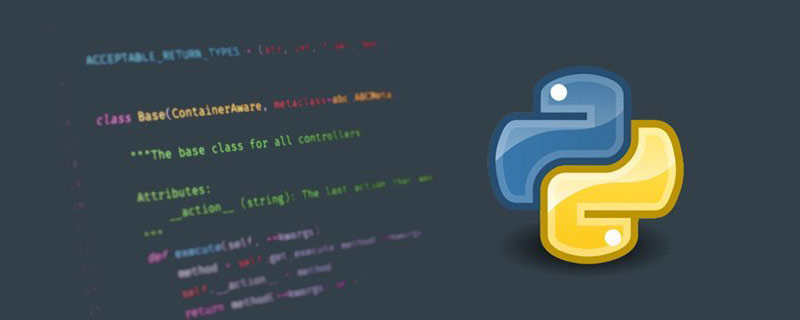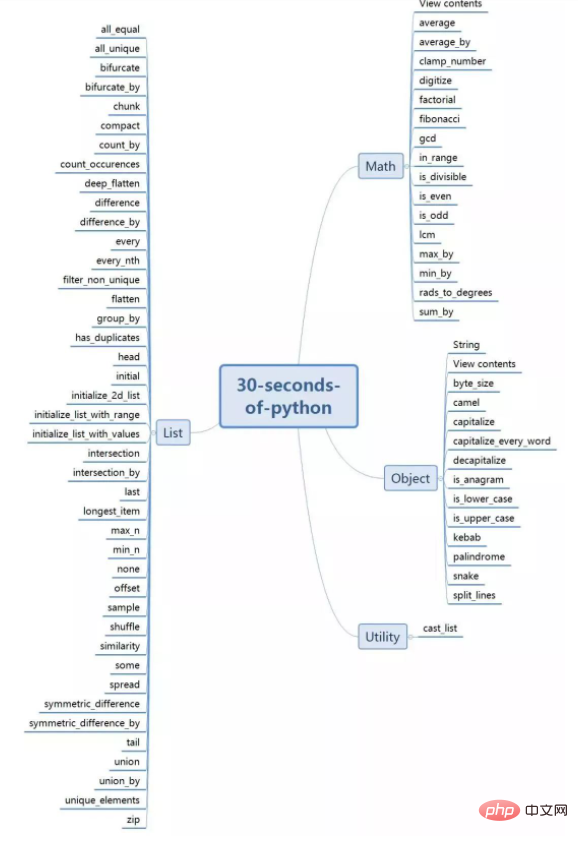Teach: Learn a Python trick every 30 seconds
Many friends who study Python video tutorial will encounter many problems in function implementation during the actual project. Some problems are not difficult, or they already exist. Great way to solve it. Of course, what makes perfect is that when we become proficient in coding, we will naturally be able to summarize some useful techniques, but it may not be so easy for those students who are just getting familiar with Python.

Recommendation (free): Python video tutorial
This time I recommend one for everyone to learn these skills A very good resource"30-seconds-of-python", all skills and methods can be obtained in just 30 seconds, and you can use your business time to accumulate them. Take a quick look below.
https://github.com/30-seconds...
Content directory
The following is the entire directory of learning Python in 30 seconds, divided into several major sections: List, Math, Object, String, Utility, the following is the organized thinking map.

I have selected 10 practical and interesting methods to share with you. The rest can be learned by yourself if you are interested.
1. List: all_equal
Function implementation: Check whether all elements in a list are the same.
Interpretation: Use [1:] and [:-1] to compare all elements of the given list.
def all_equal(lst): return lst[1:] == lst[:-1]
Example:
all_equal([1, 2, 3, 4, 5, 6]) # False all_equal([1, 1, 1, 1]) # True
2. List: all_unique
Function implementation: If all values in the list are unique, return True, otherwise False
Interpretation: Use set set() to remove duplicates on the given list and compare its length with the original list.
def all_unique(lst): return len(lst) == len(set(lst))
Example:
x = [1,2,3,4,5,6] y = [1,2,2,3,4,5] all_unique(x) # True all_unique(y) # False
3. List: bifurcate
Function implementation: Group list values. If the element in filter is True, then the corresponding element belongs to the first group; otherwise, it belongs to the second group.
Interpretation: Use list comprehension and enumerate() to each group based on filter elements.
def bifurcate(lst, filter): return [ [x for i,x in enumerate(lst) if filter[i] == True], [x for i,x in enumerate(lst) if filter[i] == False] ]
Example:
bifurcate(['beep', 'boop', 'foo', 'bar'], [True, True, False, True]) # [ ['beep', 'boop', 'bar'], ['foo'] ]
4. List: difference
Function implementation: Return the difference between two iterables.
Interpretation: Create a set of b, and use the list comprehension of a to retain elements that are not in _b.
def difference(a, b): _b = set(b) return [item for item in a if item not in _b]
Example:
difference([1, 2, 3], [1, 2, 4]) # [3]
5. List: flatten
Function implementation: one-time integrated list.
Interpretation: Use nested lists to extract each value of the sublist.
def flatten(lst): return [x for y in lst for x in y]
Example:
flatten([[1,2,3,4],[5,6,7,8]]) # [1, 2, 3, 4, 5, 6, 7, 8]
6. Math: digitize
Function implementation: Decompose a number and convert it into single digits.
Interpretation: After characterizing n, use the map() function combined with int to complete the conversion
def digitize(n): return list(map(int, str(n)))
Example:
digitize(123) # [1, 2, 3]
7. List: shuffle
Function implementation: Randomly shuffle the order of list elements.
Interpretation: Use the Fisher-Yates algorithm to reorder the list elements.
from copy import deepcopy from random import randint def shuffle(lst): temp_lst = deepcopy(lst) m = len(temp_lst) while (m): m -= 1 i = randint(0, m) temp_lst[m], temp_lst[i] = temp_lst[i], temp_lst[m] return temp_lst
Example:
foo = [1,2,3] shuffle(foo) # [2,3,1] , foo = [1,2,3]
8. Math: clamp_number
Function implementation: Clamp the number num at the boundary value of a and b within the specified range.
Interpretation: If num falls within the range, return num; otherwise, return the closest number within the range.
def clamp_number(num,a,b): return max(min(num, max(a,b)),min(a,b))
Example:
clamp_number(2, 3, 5) # 3 clamp_number(1, -1, -5) # -1
9. String: byte_size
Function implementation: Return the number of bytes in the string.
Interpretation: Use string.encode('utf-8')Decode the given string and return the length.
def byte_size(string):
return len(string.encode('utf-8'))Example:
byte_size('?') # 4
byte_size('Hello World') # 1110. Math: gcd
Function implementation: Calculate the greatest common factor of several numbers.
Interpretation: Use reduce() and math.gcd to implement on the given list.
from functools import reduce import math def gcd(numbers): return reduce(math.gcd, numbers)
Example:
gcd([8,36,28]) # 4
The above are various tips for learning python in 30 seconds. How about it? Have you gained some new inspiration for some common operations? In addition, there are many other techniques that you can slowly learn. I hope it will be helpful to all readers.
The above is the detailed content of Teach: Learn a Python trick every 30 seconds. For more information, please follow other related articles on the PHP Chinese website!

Hot AI Tools

Undresser.AI Undress
AI-powered app for creating realistic nude photos

AI Clothes Remover
Online AI tool for removing clothes from photos.

Undress AI Tool
Undress images for free

Clothoff.io
AI clothes remover

AI Hentai Generator
Generate AI Hentai for free.

Hot Article

Hot Tools

Notepad++7.3.1
Easy-to-use and free code editor

SublimeText3 Chinese version
Chinese version, very easy to use

Zend Studio 13.0.1
Powerful PHP integrated development environment

Dreamweaver CS6
Visual web development tools

SublimeText3 Mac version
God-level code editing software (SublimeText3)

Hot Topics
 1378
1378
 52
52
 How to use Debian Apache logs to improve website performance
Apr 12, 2025 pm 11:36 PM
How to use Debian Apache logs to improve website performance
Apr 12, 2025 pm 11:36 PM
This article will explain how to improve website performance by analyzing Apache logs under the Debian system. 1. Log Analysis Basics Apache log records the detailed information of all HTTP requests, including IP address, timestamp, request URL, HTTP method and response code. In Debian systems, these logs are usually located in the /var/log/apache2/access.log and /var/log/apache2/error.log directories. Understanding the log structure is the first step in effective analysis. 2. Log analysis tool You can use a variety of tools to analyze Apache logs: Command line tools: grep, awk, sed and other command line tools.
 Python: Games, GUIs, and More
Apr 13, 2025 am 12:14 AM
Python: Games, GUIs, and More
Apr 13, 2025 am 12:14 AM
Python excels in gaming and GUI development. 1) Game development uses Pygame, providing drawing, audio and other functions, which are suitable for creating 2D games. 2) GUI development can choose Tkinter or PyQt. Tkinter is simple and easy to use, PyQt has rich functions and is suitable for professional development.
 PHP and Python: Comparing Two Popular Programming Languages
Apr 14, 2025 am 12:13 AM
PHP and Python: Comparing Two Popular Programming Languages
Apr 14, 2025 am 12:13 AM
PHP and Python each have their own advantages, and choose according to project requirements. 1.PHP is suitable for web development, especially for rapid development and maintenance of websites. 2. Python is suitable for data science, machine learning and artificial intelligence, with concise syntax and suitable for beginners.
 How debian readdir integrates with other tools
Apr 13, 2025 am 09:42 AM
How debian readdir integrates with other tools
Apr 13, 2025 am 09:42 AM
The readdir function in the Debian system is a system call used to read directory contents and is often used in C programming. This article will explain how to integrate readdir with other tools to enhance its functionality. Method 1: Combining C language program and pipeline First, write a C program to call the readdir function and output the result: #include#include#include#includeintmain(intargc,char*argv[]){DIR*dir;structdirent*entry;if(argc!=2){
 The role of Debian Sniffer in DDoS attack detection
Apr 12, 2025 pm 10:42 PM
The role of Debian Sniffer in DDoS attack detection
Apr 12, 2025 pm 10:42 PM
This article discusses the DDoS attack detection method. Although no direct application case of "DebianSniffer" was found, the following methods can be used for DDoS attack detection: Effective DDoS attack detection technology: Detection based on traffic analysis: identifying DDoS attacks by monitoring abnormal patterns of network traffic, such as sudden traffic growth, surge in connections on specific ports, etc. This can be achieved using a variety of tools, including but not limited to professional network monitoring systems and custom scripts. For example, Python scripts combined with pyshark and colorama libraries can monitor network traffic in real time and issue alerts. Detection based on statistical analysis: By analyzing statistical characteristics of network traffic, such as data
 Python and Time: Making the Most of Your Study Time
Apr 14, 2025 am 12:02 AM
Python and Time: Making the Most of Your Study Time
Apr 14, 2025 am 12:02 AM
To maximize the efficiency of learning Python in a limited time, you can use Python's datetime, time, and schedule modules. 1. The datetime module is used to record and plan learning time. 2. The time module helps to set study and rest time. 3. The schedule module automatically arranges weekly learning tasks.
 Nginx SSL Certificate Update Debian Tutorial
Apr 13, 2025 am 07:21 AM
Nginx SSL Certificate Update Debian Tutorial
Apr 13, 2025 am 07:21 AM
This article will guide you on how to update your NginxSSL certificate on your Debian system. Step 1: Install Certbot First, make sure your system has certbot and python3-certbot-nginx packages installed. If not installed, please execute the following command: sudoapt-getupdatesudoapt-getinstallcertbotpython3-certbot-nginx Step 2: Obtain and configure the certificate Use the certbot command to obtain the Let'sEncrypt certificate and configure Nginx: sudocertbot--nginx Follow the prompts to select
 How to configure HTTPS server in Debian OpenSSL
Apr 13, 2025 am 11:03 AM
How to configure HTTPS server in Debian OpenSSL
Apr 13, 2025 am 11:03 AM
Configuring an HTTPS server on a Debian system involves several steps, including installing the necessary software, generating an SSL certificate, and configuring a web server (such as Apache or Nginx) to use an SSL certificate. Here is a basic guide, assuming you are using an ApacheWeb server. 1. Install the necessary software First, make sure your system is up to date and install Apache and OpenSSL: sudoaptupdatesudoaptupgradesudoaptinsta




